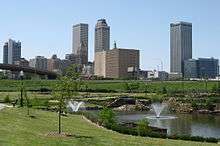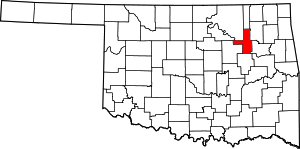Glenpool, Oklahoma
Glenpool is a city in Tulsa County, Oklahoma, United States. It is part of the Tulsa Metropolitan Statistical Area (TMSA). As of 2010, the population was 10,808. This was an increase of 33.1% since the 2000 census, which reported total population as 8,123.[5]
Glenpool, Oklahoma | |
|---|---|
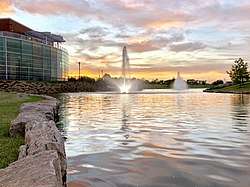 Glenpool Conference Center pond view | |
| Motto(s): "Creating Opportunity" | |
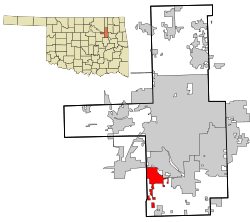 Location of within Tulsa County, and the state of Oklahoma | |
 Glenpool, Oklahoma Location in the United States | |
| Coordinates: 35°56′58″N 96°0′8″W | |
| Country | United States |
| State | Oklahoma |
| County | Tulsa |
| Government | |
| • Type | Mayor-Council |
| • Mayor | Tim Fox |
| Area | |
| • Total | 11.00 sq mi (28.49 km2) |
| • Land | 11.00 sq mi (28.49 km2) |
| • Water | 0.00 sq mi (0.00 km2) |
| Elevation | 705 ft (215 m) |
| Population (2010) | |
| • Total | 10,808 |
| • Estimate (2019)[2] | 13,936 |
| • Density | 1,266.91/sq mi (489.14/km2) |
| Time zone | UTC-6 (Central (CST)) |
| • Summer (DST) | UTC-5 (CDT) |
| ZIP code | 74033 |
| Area code(s) | 539/918 |
| FIPS code | 40-29600[3] |
| GNIS feature ID | 1102843[4] |
| Website | www |
Glenpool is notable because the discovery of oil in 1905, which caused an economic boom that propelled the growth of Tulsa and its surroundings. Although the Glenn Pool field, for which the city was named, still produces a small amount of oil; the city is now primarily a Commuter town for Tulsa.[6]
History
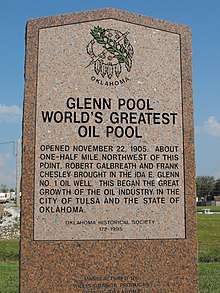
On November 22, 1905, wildcatters, Robert Galbreath and Frank Chesley (along with, by some accounts, Charles Colcord), drilling for oil on farmland owned by Creek Indian Ida E. Glenn, created the first oil gusher in what would soon be known as the "Glenn Pool". The discovery set off a boom of growth for the area, bringing in hordes of people: lease buyers, producers, millionaires, laborers, tool suppliers, drunks, swindlers, and newspeople. Daily production soon exceeded 120,000 barrels (19,000 m3). The nearby city of Tulsa benefited from the production, and Glenpool calls itself the town that made Tulsa famous.[7]
By the end of 1906 a settlement consisting of twelve families had grown up nearby. In that year, the Midland Valley Railroad extended a track from Jenks. By 1907, nearly 3,000 people had moved to the area, but only about 500 people actually lived in the town in 1910. Lots were platted and a post office opened on January 31, 1908. The new community was renamed "Glenpool."[8]
Sometime after the discovery, Ida Glenn and her husband, Robert, sold their farm and moved to California.[9]
In the early days, Glenpool was on the route of the Sapulpa & Interurban Railway (“S&I”) streetcar/interurban line connecting to Tulsa through Kiefer and Sapulpa, as well as south to Mounds; S&I subsequently went through a series of mergers and name changes, with only the Tulsa-to-Sapulpa portion continuing as the Tulsa-Sapulpa Union Railway.[10]
Population grew to 428 in 1920, but declined thereafter to 280 in 1950. A post-WWII building boom then pushed the population upward to 353 in 1960. During the 1970s and 1980s, urban sprawl of the city of Tulsa reached Glenpool, and the town became a bedroom suburb. It has been growing since. By 1970 the population had risen to 770, then to 2,706 in 1980.[8]
An annual celebration called "Black Gold Days" is a 3-day family-friendly event with food, music, arts and crafts, a carnival, and a parade.[7] It commemorates the early years of Glenpool's history.
Geography
Glenpool is located in the northeastern corner of Oklahoma, about 15 miles (24 km) south of downtown Tulsa on U.S. Route 75, a major national north–south artery.[11][12] The city is on the eastern edge of the Cross Timbers ecoregion, between the Great Plains and the foot of the Ozarks.[13]
According to the United States Census Bureau, the city has a total land area of 10.34 square miles (26.8 km2) and no water.[14]
Glenn Pool Oil Field

Muskogee Times-Democrat[15]
Saturday, May 31, 1917
Galbreath and Chesley had used their own money to pay for an oil drilling rig, with operator, and a lease on Ida Glenn's land. By November 22, 1905, they had drilled through the Red Fork Sand, the deepest known producing sand in the area without striking oil. There was a small stream of natural gas at a depth of
1,450 feet (440 m), so they decided to drill deeper. A few feet further down, the rig encountered a formation known as the Bartlesville Sand, where Chesley noticed the first trace of oil on the drill bit. The well began making a gurgling sound and soon emitted a gusher clear over the derrick. The well soon produced over 75 barrels a day of light, sweet crude oil. Galbreath and Chesley named the well Ida Glenn Number 1.[16] In 1906, Galbreath drilled another well about 300 feet (91 m) from Ida Glenn Number 1. This well was also a producer.[17]
Other people rushed to the area to begin drilling, and soon defined the extent of the field. Prices for leases and for drilling services rose sharply. Fewer than two percent of the wildcat wells failed to produce oil. Some of the Creek landowners began earning as much as a million dollars a year from royalties on the production from their 160-acre plots. According to one source,"... More money was made on the Oklahoma oil boom than the California gold rush and Colorado silver rush combined."[16]
After only one year, the Glenn Pool field had 127 completed wells. Of these, 107 produced oil, 12 found only gas and 11 were dry holes. In addition, 24 more wells were in progress and 33 sites were being readied for drilling. By 1907, the field was increasingly controlled by three companies: Texaco, Gulf Oil Company and Prairie Oil and Gas. Galbreath and Chesley were ready to move on. They sold their Glenn Pool holdings to Edgar Crosbie for $US 500,000 and $US 200,000, respectively.[17]
The Ida Glenn well was plugged and abandoned in 1964. The Glen Pool field still produces a relatively small flow of oil in the 21st Century using waterflood techniques. Over its life span, the field has produced more than 340 million barrels of oil.[16]
Climate
Glenpool is in Tornado Alley and has a temperate climate of the humid subtropical variety (Köppen Cfa) with a yearly average temperature of 60 °F (16 °C).[18]
Demographics
| Historical population | |||
|---|---|---|---|
| Census | Pop. | %± | |
| 1920 | 428 | — | |
| 1930 | 310 | −27.6% | |
| 1940 | 284 | −8.4% | |
| 1950 | 280 | −1.4% | |
| 1960 | 353 | 26.1% | |
| 1970 | 1,770 | 401.4% | |
| 1980 | 2,706 | 52.9% | |
| 1990 | 6,688 | 147.2% | |
| 2000 | 8,123 | 21.5% | |
| 2010 | 10,808 | 33.1% | |
| Est. 2019 | 13,936 | [2] | 28.9% |
| sources:[8][19] | |||
As of the census[3] of 2010, there were 10,808 people, 3,723 households, and 2,927 families residing in the city. The population density was 1,045.8 people per square mile (337.2/km2). There were 2,849 housing units at an average density of 306.4 per square mile (118.3/km2). The racial makeup of the city was 72.6% White, 2.4% African American, 13.2% Native American, 0.9% Asian (0.4% Filipino), 0.1% Pacific Islander, 2.2% from other races, and 8.6% from two or more races. Hispanic or Latino were 5.9% (4.5% Mexican).[20]

There were 3,723 households out of which 49.7% had children under the age of 18 living with them, 63.2% were married couples living together, 14.3% had a female householder with no husband present, and 18.5% were non-families. 15.7% of all households were made up of individuals and 3.8% had someone living alone who was 65 years of age or older. The average household size was 2.91 and the average family size was 3.25.
In the city, the population was spread out with 33.5% under the age of 18, 8.6% from 18 to 24, 35.5% from 25 to 44, 16.8% from 45 to 64, and 5.7% who were 65 years of age or older. The median age was 30 years. For every 100 females, there were 90.3 males. For every 100 females age 18 and over, there were 88.5 males.
The median income for a household in the city was $61,814 and the median income for a family was $66,578. The per capita income for the city was $24,096. About 5.0 of the total population were below the poverty line.[21][22]
Media
Glenpool had one newspaper, the Glenpool Post. The paper was published every Wednesday. It was owned by Community Publishers, a newspaper and Internet publisher and commercial printer that served Oklahoma, Missouri, and Arkansas. In 2012, the Glenpool Post was merged with the Jenks Journal and the Bixby Bulletin to form the South County Leader with the news focusing on Glenpool being a component in the newspaper. Ultimately, the South County Leader ceased publication in 2014.[23] The Glenpool Post was started in 1984 by Charles and Susan Biggs and sold to Neighbor Newspapers in 1987.[24]
High school sports
Glenpool High School (GHS) is classified as a 5A school by the OSSAA. Under their current head coach Steve Edwards, Glenpool High School won the Class 4A state football championship in both 2002 and 2008. In 2002, Glenpool High School went 14–0.[25][26] Glenpool won the 2016 state championship in Track and Field along with having a state champion in cross country.[27]
References
- "2019 U.S. Gazetteer Files". United States Census Bureau. Retrieved July 28, 2020.
- "Population and Housing Unit Estimates". United States Census Bureau. May 24, 2020. Retrieved May 27, 2020.
- "U.S. Census website". United States Census Bureau. Retrieved 2008-01-31.
- "US Board on Geographic Names". United States Geological Survey. 2007-10-25. Retrieved 2008-01-31.
- MuniNetGuide - Glenpool, Oklahoma. Retrieved April 27, 2011
- "Glenpool".
- "Tulsa World, June 16, 2011". Retrieved 2011-06-16.
- Carl N. Gregory,"Glenpool. Encyclopedia of Oklahoma History and Culture. (accessed October 13, 2013)
- Zizzo, David. NewsOK "Glenn Pool discovery led oil boom. Preservationists are trying to make sure the impact on Oklahoma is not forgotten." November 22, 2004. Retrieved May 6, 2014.
- "Tulsa Sapulpa Union Railway". American-Rails.com. Retrieved January 18, 2019.
- "Map of Glenpool on Mapquest". Retrieved 2011-06-16.
- U.S. Route 75
- "The Ancient Cross Timbers". University of Arkansas. Archived from the original on 2006-09-08. Retrieved October 13, 2013.
- "Quick Facts: Glenpool city, Oklahoma". United States Census Bureau. Retrieved 12 July 2018.
- Muskogee Times-Democrat. May 31, 1917. Missing or empty
|title=(help) - Glenn Pool Oil Field Educational Center. "History of the Oil Boom: The Ida E. Glenn Discovery." Retrieved May 6, 2014.
- Davenport, Linda Haas. "History of Glennpool, Oklahoma." Archived 2017-09-04 at the Wayback Machine Retrieved May 6, 2014.
- "Oklahoma Climatological Survey" (PDF). Board of Regents of the University of Oklahoma. Retrieved 12 July 2018.
- "CENSUS OF POPULATION AND HOUSING (1790-2000)". U.S. Census Bureau.
- "Archived copy". Archived from the original on March 5, 2014. Retrieved November 25, 2012.CS1 maint: archived copy as title (link)
- "Archived copy". Archived from the original on 2012-10-24. Retrieved 2012-07-27.CS1 maint: archived copy as title (link)
- United States Census
- A page in history turns as the Glenpool Post stops publication | Tulsa Beacon Archived 2015-04-02 at the Wayback Machine (accessed May 7, 2015)
- By former publisher Charles Biggs, editor and publisher of the Tulsa Beacon newspaper.
- OSAA State football championships Archived 2009-08-22 at the Wayback Machine, Retrieved 2009-12-08.
- Rivals High High School State Champions 2008 Archived 2011-07-15 at the Wayback Machine, Retrieved 2010-03-21
- "High school track: 6A/5A state meet results". Tulsa World. BH Media Group. Retrieved 12 July 2018.
External links
| Wikimedia Commons has media related to Glenpool, Oklahoma. |
